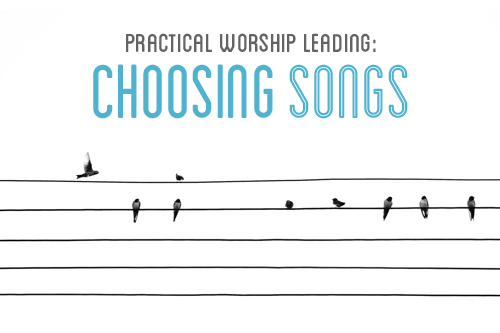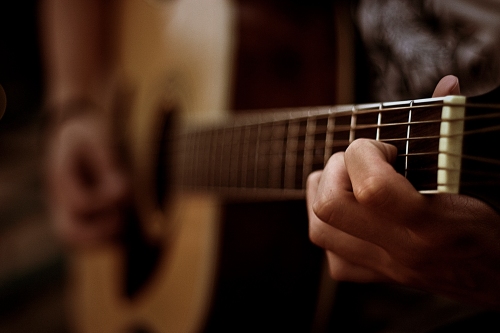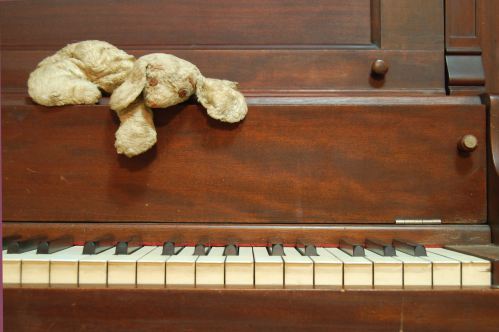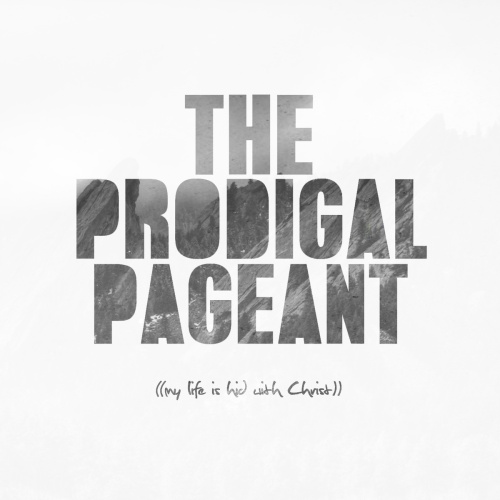
Photo Credit: Guillermo Galan via Compfight cc
Each week, worship pastors are faced with what seems like a simple, repetitive task: choose songs for this week’s services. While it would be fairly easy to simply string together a random list of the most recent songs we’ve been wearing out on Spotify, there should most likely be some more objective or nuanced reasons for choosing the songs we sing each week.
One quick note: all of the following is written with the assumption that you have built up a list or repertoire of songs that already pass some basic tests for good worship songs (Are they true? Are they beautiful? Are they singable?). I’ll write another blog post soon about some of those tests and some of my thoughts on choosing new songs to add to your repertoire. For this post I’ll focus on some of the key things I try to keep in mind as I’m choosing songs from an already existing list, in order to plan a service.
That being said, here’s a quick list of the main things I think about as I go through this weekly task. Different worship leaders put different emphases on different points, but this is more or less the order I use:
- Instruments
- Themes
- Song History
- Liturgy
- Style Balance
- Flow
1. Instruments: Who’s playing?
One of the most basic things that I need to know before choosing songs for a service is who else I’ll be playing with. Whether we have a full band (drums, bass, keys, electric, acoustic, vocal harmonies), a “coffee shop” setup (percussion, keys, acoustic), or just myself and an acoustic guitar, will really determine what types of songs I’m going to choose. Also, depending on the skill level of the musicians playing with me, I can choose songs that tend toward their personal strengths, or I’ll know when to stretch them by trying something they’re not quite as comfortable with. Know your team and you’ll have a much better feel for which songs they’ll be able to play well together.
2. Themes: What are we talking about?
The next thing I think about is the underlying themes of the service. If I know which Bible passages or topics are being discussed, I can take a moment to look them up and start to become familiar with the subject matter. Are there repeated words or phrases in the passage? Do any songs come to mind right away that use the same language or discuss the same topics? Often, just grabbing a piece of paper and writing down key words or phrases and grouping them together can be really helpful.
3. Song History: What songs have we sung recently?
It’s also important to think about the songs we’ve sung recently (or haven’t sung in a long time). Did we introduce a new song last week that should be repeated to help people learn it? Are there any songs that I should avoid using because we’ve sung them too recently or too often? This is where tools like a Song History spreadsheet can really come in handy (post coming soon). I’ve found it helps to keep track of all of our songs and when we’ve sung them so that I can avoid too much or too little repetition.
4. Liturgy: What songs will help to tell the Gospel story?
As Jesus’ church, we’re called to live in the good news of his Gospel and proclaim it to the world. Musical worship is one beautiful and effective way that we can do that. Each time I lead worship, I try to include the following primary elements of the Gospel within the service— even if they appear in different ways or in a different order depending on the setting.
On a very basic level, here are the elements I try to include each time I lead:
- ADORATION:
Praising the greatness and holiness of God. - CONFESSION:
Admitting that we have rebelled against God, both in the things we have done and the things that we have failed to do. - ASSURANCE OF GRACE:
Recognizing our need for Jesus to reconcile us to God, remembering Jesus’ work on our behalf, and rejoicing in the hope we have through him. - THANKSGIVING AND SUPPLICATION:
Asking for God’s help, in Christ and through the Spirit, to live grateful lives that please Him.
Using this list can really help us as worship leaders to tell the Gospel story each time we lead. It can also help us to avoid falling into ruts of our own personal pet topics and never singing about anything else. I try to choose songs that fill in as many of these liturgical categories as I can, and then either read scripture or verbally connect the dots during the service to fill in the rest. For more information on this type of liturgy, see “Christ-Centered Worship” by Brian Chapell.
5. Style Balance: old/middle-aged/young songs, familiar vs. unfamiliar, complex vs. simple
Throughout the Bible we see our rescuing God calling and redeeming a wonderfully diverse group of people for Himself: people from every tribe, tongue, people, and nation. This includes people from different ethnicities, people of different ages, people with different church backgrounds, and people with different musical tastes. I believe that as much as possible we should keep this in mind as we seek care for and lead our congregation in a wise and compassionate way.
Just talk to a single row of people at your church, and you’ll quickly find that their opinions and preferences can vary a whole lot. Some people only love songs from 400 years ago, some people only love songs from 20-30 years ago, and some only love songs that came out yesterday (or they’re currently writing in their heads!).
As I plan each service, I try to keep in mind the styles of the songs I’m choosing, trying not to weigh in too heavily on one category over another. Have I chosen only brand new songs, or have I included ancient hymns or “middle-aged” popular choruses as well? Are we only singing musically complex, syncopated musical forms, or have I included smooth, simple arrangements and melodies as well? Are we only singing vast, expansive theological treatises or are we also including songs that have a few simple truths and allow us slow down and soak in them? (The Psalms include both!)
6. Flow: What songs will transition well from one to the other?
Avoiding awkward pauses or jarring breaks in the service can be very important in order to help your congregation focus on drawing near to God instead of wondering what their worship leader is doing. There are at least two main things to consider when trying to plan for smooth transitions from one song to the next: keys and energy.
- KEYS: Putting two songs together that are in the same musical key is by far the easiest way to smoothly flow from one to the next without awkward pauses. In many cases, you can seamlessly flow from one song to the next without any silence at all. As you’re choosing songs, this is a good thing to keep in mind.
- ENERGY: In general, it’s a good idea to put songs with similar amounts of energy together. When planning a service, try to avoid jumping from a super energetic, fast song to a slow, contemplative one and then right back up to a really fast song. It would probably be a much better idea to do something like a slow song, then a medium song, then a fast song, or the other way around. If you think of the service as a landscape, try to avoid dropping people off of cliffs by jumping from a fast song down to a really slow song. In the same way, try not to emotionally slam them into walls by jumping from a really mellow song straight up into an extra energetic one. Instead, think gradual hills and valleys.
As with many guidelines there are exceptions, but I hope these will be some helpful rules of thumb that you can use as you’re choosing songs each week. If you think I’ve missed anything or have any questions, give me a shout!
Filed under: Practical Worship Leading | 1 Comment

Photo Credit: Bert Kaufmann via Compfight cc
A friend of mine recently drew my attention to a blog post I wrote back in 2009, called “You are Either Helping or Hurting Your Church“. As many blog writers have said before me, it’s amazing to see how our views on things can grow and change. I think there is truth to be heard in that little post. I think that someone reading it could be encouraged to stop critiquing the church and start being the church. That’s my hope. But in retrospect, the post said the word “Gospel” quite a few times without actually attempting to apply it.
The Church is for Failures
Here’s the truth: in order to believe the Gospel, at some point we must fully admit that we are broken and helpless— that we are unable to do the good that we know that we should do. We fall short. We are inadequate. We are destructive both to ourselves and those around us, and we need help. The good news of the Gospel is that God sent his son Jesus to rescue us, and through the Spirit, he draws us to Himself, grants us a hard-won pardon, and works in us His goodness.
When we trust anything other than God at work in us through the Gospel, we inevitably hurt the Church. And the only way to ever help the Church is to trust God more through the Gospel. We do have a responsibility to respond to the Gospel, but we have a perfect and faithful Helper— the One who granted us the ability to do any good in the first place. By Him and through Him and to Him are all things. So take heart! We do not bear the ultimate weight of our own goodness. Without Jesus, we are unable to even become a part of the Church, much less help it. But through him, we are more than conquerors.
God (Still) Bears the Weight of Our Goodness
The point is this: let’s work hard, but never lose sight of where every ounce of our strength comes from. We don’t graduate from dependence on God, we grow deeper into it. Trust Jesus. Know and respond to the good news of the Gospel. We can’t work hard enough or do enough or pull ourselves up by our own bootstraps. We couldn’t do it before we trusted Him, and we can’t now. We still need Jesus if we’re ever to do anything of lasting good. Rest in him, and work in him. Be the church that you want to be a part of.
Filed under: Uncategorized | 1 Comment

Photo Credit: Prabhu B Doss via Compfight cc
How do you decide whether or not to bring an original worship song to the congregation? (Even when there are obviously better songs in existence?)
I lead worship music at a local church. I write songs. I have a passion to unite truth and beauty in a Biblical and accessible way. I want these songs to inspire and inform— to build the Church and to help us to live passionately as the advancing Kingdom of God. Recently, I came up against the following question: How do I determine whether or not to bring an original song of mine before our congregation?
Here’s the deal. Every time I write a song, there are arguably hundreds of other better songs in existence. They say it better. They play it better. (Their YouTube videos are filled with swirling beauty and perfect lighting and cool-looking people and blurry, worship-y goodness.) Let’s just say it like this: a head-to-head battle between my little worship song and some of the awesome tunes out there would probably go a lot like a prize fight between Mickey Mouse and Darth Vader.
But this week, we’re singing a song of mine.
Here are some of my thoughts on why, and it’s my hope to encourage other worship leaders to wrestle with some of these concepts for themselves:
1. YOU are part of the context.
If you’ve read any amount of recent blog posts on worship leading, you’ll have heard the word “context” thrown around a lot. And I won’t argue that it’s an important thing to consider as we lead worship. Are you leading worship for former gang members downtown in renovated strip club, or for a congregation of faithful elderly farmers in a barn in rural Nebraska? Context matters. But, context can’t always help us with specifics (such as exactly which songs to sing from week to week).
As a part of any group of people, we come with an amazingly diverse set of pains and preferences. Take two different people sitting on the same row on a given Sunday and ask them to write down their top five favorite worship songs of all time. How different would their lists be? How well would we be able to guess that list, based on our “context”?
Part of the equation of defining the context must to be this: you are there, leading them. God has put you where you are, doing what you are doing, for a reason. If you’re a songwriter and you’ve been put in a leadership role at your church, it’s your God-given responsibility to determine Biblically, prayerfully, with humility and wisdom, how God would like to you to invest your talents for His glory and the good of His people.
2. THE best is relative. Bring YOUR best.
These days, as creatives, it can be very easy to feel that you’re in a global competition with the all the other obnoxiously talented denizens of the internet. You’re not. What you are in is something much bigger than that. You are joined alongside other believers in a spiritual battle to bring glory to God in as many ways and as many places as possible. You’ve been handed a unique set of weapons and you need to use them, and use them well. You are not in a fight to prove yourself, but a thankful race to bring honor to the One who proved Himself enough for us. You are not in a contest with the worship leader across the country or across the street, you are in a struggle with the forces of darkness and your own pride, misplaced fear, and apathy. Our goal cannot be simply to write hit songs, or even to musically convince our congregation of God’s worth. Instead, it must be to worship faithfully and fearlessly in our own lives, with our own head, heart, and hands. And by the way, that’s much more than just music.
3. Take God-inspired risks and learn from them.
The church needs skilled people doing what they do for the Glory of God and the good of His people. Even if it means digging through the perceived garbage dump of our own mediocre efforts in order to find something worth keeping, we must keep digging. We have to be willing to risk doing something badly many times in order to learn how to do it well— to experience temporary failure in order to achieve lasting success.
Whether you’re a plumber or a songwriter, God has made you that way to reveal His glory and to build His church. I have no idea if a song I bring before the congregation is going to resonate with their hearts or simply bring a pained expression to the face of the guy in the second row. But I need to be willing to risk many, many failures to learn and grow and to allow God to work through my stumbling efforts.
And finally, I must be willing to listen to feedback and grow from it. We can only be fearless in our creative endeavors if our identities are not ultimately tied to the results. If we are secure in our status as loved children of the living God, we can be ready to admit when something was a mistake or a misfire, to learn and grow and seek to improve. And, we can be ready to celebrate when God takes our tiny drops of paint and does something more beautiful than anything that we could ever as or imagine.
Filed under: Uncategorized | Leave a Comment
The Prodigal Pageant is a modern worship band that hails from The Well Church in Boulder, Colorado. My Life is Hid with Christ is their second EP, which was recorded and produced in their personal Studio, The Listening Well.
From the very first swirling, riff-driven moments of the opening track, My Life is Hid with Christ promises a modern rock-influenced experience that it fulfills throughout the three-song EP. With a marriage of strong creative melodies and thoughtful Christ-centered lyrics, the latest effort by The Prodigal Pageant offers a compelling collision of truth and beauty. The well-built musical foundation for each track provides a solid platform that supports and carries the weight of hope and identity that is welded to the lyrics of each song.
Even within the span of just these few tracks, The Prodigal Pageant displays versatility and stylistic diversity while still maintaining a cohesive set of flavors that are consistently baked into the musical identity of the group. If you’re a fan of swelling, textured, guitar-driven rock occasionally sprinkled with well-placed trumpet solos, this EP might just be for you.
As a whole, My Life is Hid with Christ presents a well-written triad of solidly theological anthems— songs of worshipful dependence upon a God who both saves and secures. Combining creative turns of musicality with rich dynamics and coherent musical sensibilities, these songs are at home in the happily growing landscape of well-crafted art that both thrives in and fuels gathered worship.
Filed under: Uncategorized | Leave a Comment
Object Writing: “Guitar”

Picture by sofamonkez
Recently a friend recommended a book to me, called “Writing Better Lyrics” by Pat Pattison. I’m only a chapter into it, but I thought I’d share a little bit of what I’ve been working on.
In the book, Pattison encourages songwriters to get into the habit of a daily exercise called “object writing”. The idea is to arbitrarily pick an object and to describe it using sense-bound words (sight, sound, smell, taste, touch, as well as “organic” and “kinesthetic”). Set a timer for ten minutes, and make yourself stop at the end.
I’ve been using this exercise over the last few days, and it’s been a fun, therapeutic way to start my days. I’ve been pairing it with some Bible reading, since I’d much rather get better at loving Jesus than being a better songwriter =). Today’s word was “guitar” (based on a quick reference to stringed instruments in Psalm 45). While I’m ever wary of the subtle strangling effect of writing something that I know people will eventually read, I thought I’d start sharing some of the pieces that I thought were slightly less embarrassing than the others. Here’s “guitar”:
Wound strings: fingers sliding on their tracks like saw tooth railways. The perfect pressure to pull from the wood a warm, coursing note—colored in subtle ways by the calluses on our fingers. The sound flows outward like ribbon-streams, flowing against ears and walls, entering the landscape of our thoughts. You may listen, but will you hear?
Even leaving, our fingers will smell of steel— like aged miners, well-versed in the delicate toil of descending past a seemingly obvious surface reality, down the light-sparse shafts of imagination and memory, to return to the surface with what is.
Taste the blood in your tongue. Feel once again the throbbing rhythm in your veins. Be amazed as you were on that long-forgotten that day when your heart was gifted its first kick drum pulse.
Life is music. Find it. Sing it.
Filed under: Object Writing | Leave a Comment
Twinkle, Twinkle, Little Star

In preparation for our next sermon series in the Psalms, Pastor Dave encouraged me to listen through a seminary course on Christian Worship by Dr. Mark Dalbey. In the first lecture, Dr. Dalbey used a beautiful illustration that I wanted to share:
At the end of the day, it is Christ’s voice that makes the music pleasing to God. When He joins His voice with the most musical human earthly expression of music, what God hears ultimately is the voice of Jesus. And if He joins His voice to the most out-of-tune music that causes great pain to the ears of those who appreciate good music, what God hears is the voice of Jesus. I think we need to strive for musical excellence but also recognize that ultimately what is most important is the voice of Jesus joined with us.
I once heard a story that may or may not be actually true, but it is a great story. A great concert pianist, Paderewski, was giving a concert in New York City. There was a mother who brought her young boy of seven years to the concert to try to inspire him to want to practice the piano more for his piano lessons so that he could become a great piano player.
Before the concert began the mother saw someone she knew and was carrying on a conversation with them. The little boy slipped away from her and went backstage through a door that said, “Do Not Enter.” In another moment he was out on the stage with the beautiful grand piano, sitting at the piano playing with one finger “Twinkle, Twinkle Little Star” (a very simple children’s tune).
The crowd hushed and then was horrified. What an awful, horrible thing that a woman let her little boy go up on the stage! This could ruin the whole evening, they were thinking.
Just then, Paderewski stepped out on the stage. He motioned to the crowd to be quiet and not to worry. He came up to the little boy and put his arms around him and whispered in his ear, “Keep playing.” So the little boy kept playing “Twinkle, Twinkle Little Star” with his one-note arrangement. Paderewski played beautiful melodies and counter melodies that incorporated “Twinkle, Twinkle Little Star.” The crowd gave them a standing ovation.
And do you know what they probably went home and told everyone when asked about the best part of the evening? It was not what happened after, which I am sure was great and wonderful. It was what he did to incorporate this simple expression of a children’s tune. I am sure the kid thought he was doing a great job, playing on the piano in front of all those people. But the one who made it beautiful was the concert pianist, Paderewski.
For us worship is much like that. We tend to think we have it right, we have good musicians to play as we sing, or whatever it may be in different elements of worship. We tend to think we have it together and that God is pleased because we are so great. But we are actually like the little boy playing “Twinkle, Twinkle Little Star.”
That is an important thing to remember. I think we should strive to play “Twinkle, Twinkle Little Star” with the most musical excellence that we can. But remember that Christ is the one who makes it beautiful in the ears of God because of His redemptive grace for us.
– Dr. Mark Dalbey
Filed under: Uncategorized | Leave a Comment
Psalm 24: A Response (vv1-2)
Psalm 24:1-2 (NLT)
1 The earth is the Lord’s, and everything in it.
The world and all its people belong to him.
2 For he laid the earth’s foundation on the seas
and built it on the ocean depths.
The earth is Yours:
everything that fills it—
movement, colors, weight, mass, breath—
everything belongs only to You.
My heart is a comma
in the vast, continuing masterpiece of creation;
a pause between the headlong rush
of two full and furious stretches of time.
You are the builder:
In the pre-dawn silence—
out of the immovable, concrete dark
You raised columns of shivering light,
brick by shining brick.
Within the uncertain, swirling chaos
of the ocean’s crushing tomb
You placed an immovable piece of Yourself:
the first cornerstone of life,
the starting foothold from which to birth existence.
Filed under: Uncategorized | Leave a Comment
Tension and Newness

I recently got to sit in on an interview about Christianity and culture with recording artist Michael Gungor. In the course of the conversation a phrase from one of his answers really stuck out to me: “Without doubt, there can be no newness.”
While I’m still chewing on the merit and implications of this statement for us humans, I don’t think his answer stands as a universal statement— and I don’t think it was meant to. But it made me interested in trying to find the deeper truth that I resonate with.
One easy way to determine if a statement about creativity or newness is universal is to try to apply it to God. Did God have some sort of doubt that motivated Him to set into motion the newness of creation? Most of us would quickly and easily answer, “no.”
…
As I was driving home from the interview with a friend of mine, we had a good time trying to analyze the statement and see if we could come up with something that would apply to all forms of creation in all situations. We tenatively settled on this:
Without tension, there is no newness.
If we attempt to apply this statement to God’s creation of the universe, I think it passes the test. Why did God create everything? The best answers are probably, “because He wanted to,” or “because it would glorify Him.” In both of these statements we see a tension between existence as it was, and existence as He determined it should be. And so, before the newness: tension.
Again, as we follow the narrative of the Bible, we quickly reach the fall of man through sin, and inevitably to redemption by way of God’s rescue of mankind through Jesus Christ. There was a tension: a broken relationship between God and man. There was a friction between the character of God and the sinful rebellion of the human race. And so, through Christ’s life, death, and resurrection: newness. Following the heartbreaking tension of sin, God created a new, lasting, massive beauty in the form of redeemed man.
As created beings made in the image of God and living inside His story, we see the same pattern of tension and newness in our own creative work. Songs, poetry, films, painting— all are birthed out of a tension, a “necessitating vision”, of one kind or another. Men and women commit to the newness of marriage because of the tension between the thoughts of a life apart and a life together. Children are raised as works of living art by parents who feel the tension between the two possible types of adults that they could grow up to be.
What can this teach us? Hopefully, this can make ready for— and less afraid of— the inevitable tensions that will arise in our lives. Trusting God as the perfect Creator and Sustainer, we can hold tight and push through these times of tension, knowing that He is birthing something new on the other side. We can be careful not to short-circuit the process of tension and resolution in newness. If we know that there is beauty on the other side, we can cling to God and press in to Him. Instead of raging against the story line or self-medicating and numbing ourselves in order to escape it, we can allow it to grow in us a hope in the One who brings light out of darkness.
And in the end our hope is that, after the often discordant arrangement of this life, God has prepared for us a the perfect symphony of His nearness that will last beyond time.
Filed under: Uncategorized | 1 Comment
7in7 2012 Strategifying
7in7 2012 start tomorrow! In an attempt to avoid getting lost in the trenches, here’s a sort of mind map of the things I’ve been thinking in preparation for the songwriting marathon.
General Thoughts
- Don’t get lost in production. Use your iPhone and SoundCloud. Spend your time writing, not recording/mixing. Embrace the roughness.
- Start with musical hooks instead of just lyrical thoughts (which are my tendency). Or, think of a topic / lyrical direction and think about the big picture musical tone that would fit. Then start writing a musical hook.
- Listen to more music than usual, focusing on what you like.
- Try starting the writing process with different instruments initially to break out of musical ruts:
Initial Instruments
- Acoustic Guitar
- Electric Guitar
- Keys – piano tone
- Keys – synth/strings tone
- Keys – Rhodes tone
- Bass
- Ukulele
- GarageBand loop
Topical Ideas
- Liturgy (Creation/Fall/Redemption/Recreation)
- Law vs. Trust
- Kids/family
- Wife
Lyric Fodder
- Bible (try reading it in The Voice as well!)
– Isaiah 53:4-6
– Psalm 65
– Psalm 91
– Romans
– Ezekiel 37:1-14 - Dave’s latest sermon
- “In Christ, I’m Not a Sinner”
- Solid Joys
- Let the Nations be Glad
- My Utmost for His Highest
- Hanging out with my wife
- Hugging my kids
Filed under: Uncategorized | 1 Comment
When I create art, I want it to be perfect. I’ve always struggled with not wanting to “tie the bow” on something that doesn’t live up to my own standards. The problem is, art is never perfect*. But it’s still worth making.
That’s the place I’ve been coming from with some of my recent tweets / status updates. I think they sum up my little philosophical journal pretty well:
Treating art as a science will only get you so far. Our art is made by broken people using broken mediums to connect with a broken audience.
Don’t get lost chasing perfection. “At some point, you have to take your finger painting to God and say, ‘Look what I made!'” – Dave McMurry
Progress made in reality is better than perfection left in theory. Perfection is an ongoing pursuit.
Our God takes pleasure in unbreaking things.
Broken Art is Necessary
If all we ever do is try to produce fully-formed, shiny little nuggets of beauty that can hold their own in a global artistic death match, we won’t produce very much at all. We’ll miss out on the mistakes and half-blind attempts that are stepping stones to the things that are truly beautiful. We’ll won’t get the practice and the experience that we need to create rare beauty if we aren’t willing to make mistakes. Only God can create perfectly, instantly, without tiring, and without using building blocks that already exist. For us humans, we need to be able to embrace that our art will be imperfect, but that we can rest in the renewing grace of a loving God.
The 7in7 Madness
Right about this time, I ran across an event called “7 in 7“, put on by a church in Austin. Here’s how they describe it:
“7in7 is a community of artists creating 7 pieces of art in 7 days.
We write 7 songs in 7 days. 7 new songs. 7 complete songs.”
So I’m in. Definitely not my usual creative process, but I think it’ll be a healthy step in the right direction. In fact, in an effort to start “training” for this marathon, I wrote the following song. It took me three days this time, but hopefully I can get faster as 7in7 approaches. The bigger deal for me is making this flawed little song available for other people to listen to. But stubborn resistance to self-promotion, and perfectionistic OCD aside, I think I need to start finishing songs and finding out how they resonate with other people. Let me know what you think!
Between the Wrong and the Right
VERSE 1:
These choices, they drop like a ledge
Seems like each way I turn it could be my last breath
I’ve been holding it hours and hours
I don’t have much leftYou told me You’d wait for me here
I’ve been running in circles, been hiding my fears
‘Til it feels like I’m lost in myself, lost in myselfCHORUS:
If I don’t fall choosing tonight
In the dim light between the truth and the lies
‘Mid the shades of the colors and light
Will You be with me here, between the wrong and the right?VERSE 2:
It feels like the slower you bleed
The longer it takes just to find what you need
To start healing places you know that you can’t even seeWaiting between all these days
But there’s always that something that takes you away
So you never have time just to be, time just to beVERSE 3:
Maybe You’re right behind me
Wondering when I’ll just half turn around
And I’ll smile and I’ll shake in relief
‘Cause You’re carrying me
* God is the exception… keep reading.
Filed under: Uncategorized | 2 Comments

